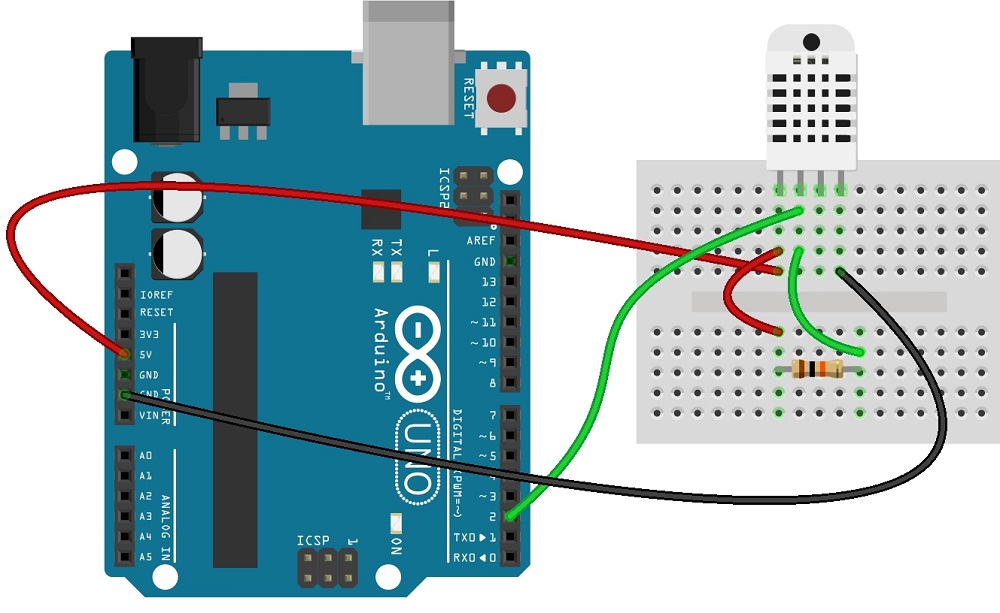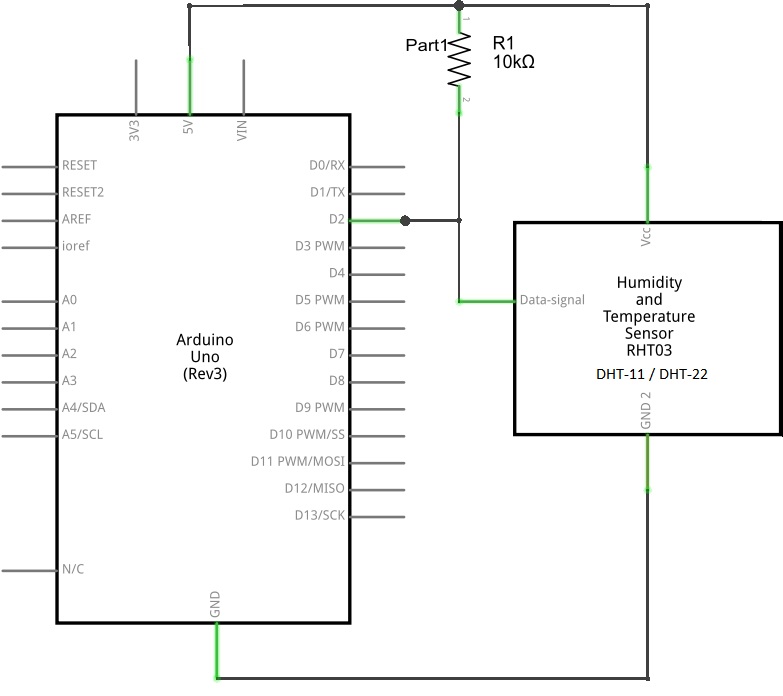Last Updated on March 16, 2024
For humidity and temperature reading the DHT22 sensor will be the perfect choice. It can read 0 to 100% humidity and 0 to 120°C temperature.
The humidity sensor DHT22 is an affordable and easy to use sensor. To use this sensor with arduino boards you need to have DHT library file, you can get here.

Circuit diagram

To wire up this sensor with arduino follow these steps, first connect bias to sensor that is +Vcc 5 volt to pin 1 and Ground GND to pin4. Then put external resistor 10K Ω between +Vcc and pin 2 for to get accurate value. Finally connect the pin 2 of sensor to any one digital pwm pin in arduino board here we connected in Digital pwm D2 pin. The sensor pin 3 need not to be connected anywhere.
Arduino Humidity (Temperature) Sensor sketch code
Use the following arduino code to print the humidity and temperature value in serial port. Using this sensor we can control many electronic peripherals.
[code]
#include “DHT.h”
#define DHTPIN 2 // what pin we’re connected to
// Uncomment whatever type you’re using!
//#define DHTTYPE DHT11 // DHT 11
#define DHTTYPE DHT22 // DHT 22 (AM2302)
//#define DHTTYPE DHT21 // DHT 21 (AM2301)
// Connect pin 1 (on the left) of the sensor to +5V
// NOTE: If using a board with 3.3V logic like an Arduino Due connect pin 1
// to 3.3V instead of 5V!
// Connect pin 2 of the sensor to whatever your DHTPIN is
// Connect pin 4 (on the right) of the sensor to GROUND
// Connect a 10K resistor from pin 2 (data) to pin 1 (power) of the sensor
// Initialize DHT sensor.
// Note that older versions of this library took an optional third parameter to
// tweak the timings for faster processors. This parameter is no longer needed
// as the current DHT reading algorithm adjusts itself to work on faster procs.
DHT dht(DHTPIN, DHTTYPE);
void setup() {
Serial.begin(9600);
Serial.println(“DHTxx test!”);
dht.begin();
}
void loop() {
// Wait a few seconds between measurements.
delay(2000);
// Reading temperature or humidity takes about 250 milliseconds!
// Sensor readings may also be up to 2 seconds ‘old’ (its a very slow sensor)
float h = dht.readHumidity();
// Read temperature as Celsius (the default)
float t = dht.readTemperature();
// Read temperature as Fahrenheit (isFahrenheit = true)
float f = dht.readTemperature(true);
// Check if any reads failed and exit early (to try again).
if (isnan(h) || isnan(t) || isnan(f)) {
Serial.println(“Failed to read from DHT sensor!”);
return;
}
// Compute heat index in Fahrenheit (the default)
float hif = dht.computeHeatIndex(f, h);
// Compute heat index in Celsius (isFahreheit = false)
float hic = dht.computeHeatIndex(t, h, false);
Serial.print(“Humidity: “);
Serial.print(h);
Serial.print(” %\t”);
Serial.print(“Temperature: “);
Serial.print(t);
Serial.print(” *C “);
Serial.print(f);
Serial.print(” *F\t”);
Serial.print(“Heat index: “);
Serial.print(hic);
Serial.print(” *C “);
Serial.print(hif);
Serial.println(” *F”);
}
[/code]
Components List
| S.No | Name | Quantity |
| 1. | Arduino uno | 1 |
| 2. | Humidity sensor | 1 |
| 3. | Resistor 10K Ω | 1 |
| 4. | connecting wires | as required |
